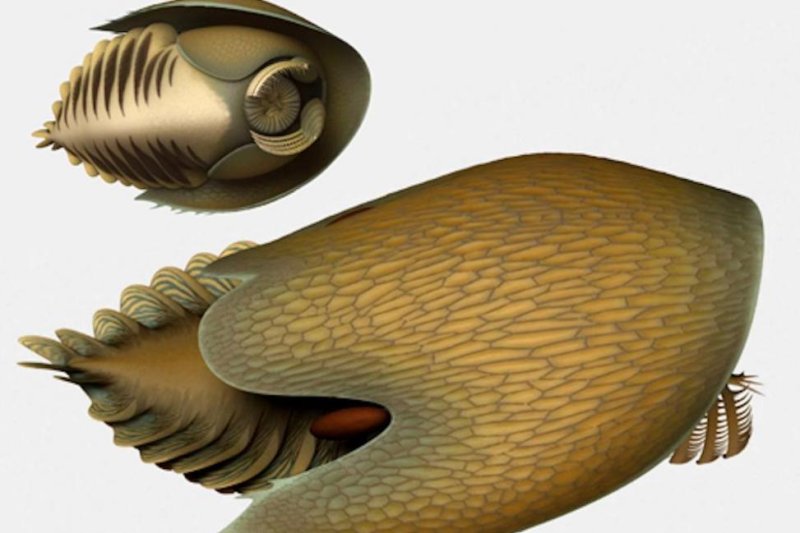Researchers discovered a new species of marine predator, a horseshoe crab-like creature, in ancient shale deposits in the Canadian Rockies. The species used its rake-like claws to sift through marine sediment in search of food. Photo courtesy Royal Ontario Museum
Aug. 1 (UPI) -- Paleontologists have discovered a new Cambrian predator species hiding among the ancient rocks of Kootenay National Park in the Canadian Rockies.
The newly discovered species, now extinct, was one of largest predators on Earth during its heyday 500 million years ago. With a large, horseshoe crab-like head and a big, curving mouth -- shaped like a pineapple slice, according to researchers -- the species would have been hard to miss.
Scientists named the new species Cambroraster falcatus.
"The rake-like claws and the large shell-like carapace provide evidence that Cambroraster spent its time hunting for buried prey near the sea floor," Joe Moysiuk, a graduate student based at the Royal Ontario Museum, told UPI.
According to Moysiuk, some modern crustaceans, as well as a few extinct sea scorpion species, use similarly shaped appendages to sift through the seafloor mud and sediment in search of food.
Though Cambroraster falcatus likely looked a bit unusual -- menacing, perhaps -- with its textured tail and its rake-like claws, its size is what really set the species apart. Growing up to a foot in length, only a few other predators could match it during this period.
In addition to being large, the species was abundant, which helped scientists slowly piece together the puzzle of Cambroraster falcatus. Over the last several years, scientists recovered dozens of Cambroraster falcatus fossils from Kootenay's 506-million-year-old Burgess Shale deposits.
"No single fossil tells the whole story," Moysiuk said. "When we initially uncovered parts of Cambroraster, we weren't sure what kind of animal we were looking at. It was only after the discovery of additional fossils, particularly last summer, and our efforts to piece them back together like puzzle pieces, that we could be confident of our conclusions."
Analysis of the fossils helped scientists place the new species on its family tree -- with extinct cousins of insects, spiders, and crabs.
"Cambroraster is a member of an extinct animal group called the radiodonts, distant evolutionary cousins of insects, spiders, and crabs," Moysiuk said. "Some radiodonts are known to have captured large, fast prey with their flexible claws, while others strained plankton from the water. The appearance and mode of feeding in Cambroraster are quite different from these close kin, suggesting a higher level of diversity in the group than was appreciated."
Additionally, the new research, published this week in the journal Proceedings of the Royal Society B, offered scientists fresh insights into the process of rapid diversification that characterized the late Cambrian period.
"The Cambrian period is renowned for the rapid evolution of many of the major groups of animals that still survive today," Moysiuk said. "This evolutionary 'explosion' opened up a lot of new ecological opportunities, or ways for organisms to eke out a living in the increasingly complex ecosystem. The evolution of Cambroraster, and the high diversity of early arthropods more generally seems to be a symptom of these crucial events in Earth's history."
As to why the newly named species ultimately disappeared, scientists can't say for sure. It's most likely, Moysiuk hypothesized, that Cambroraster was eventually outcompeted for resources by its distant relatives, the crustaceans.















